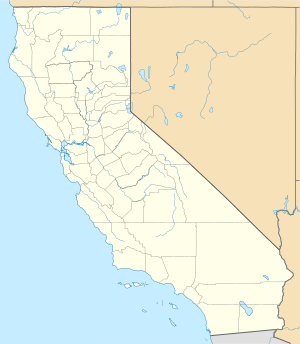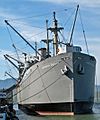SS Jeremiah O'Brien facts for kids

SS Jeremiah O'Brien
|
|
Quick facts for kids History |
|
|---|---|
| Name | Jeremiah O'Brien |
| Namesake | Jeremiah O'Brien |
| Owner | War Shipping Administration |
| Operator | Grace Line, Inc. |
| Port of registry | |
| Builder | New England Shipbuilding Corporation |
| Yard number | 230 |
| Laid down | 6 May 1943 |
| Launched | 19 June 1943 |
| In service | 3 July 1943 |
| Out of service | 7 February 1946 |
| Identification |
|
| Status | Seagoing museum ship |
| General characteristics | |
| Class and type | EC2-S-C1 (Liberty ship) |
| Displacement | 15,928 short tons (14,450 t) |
| Length | 441 ft 6 in (134.57 m) |
| Beam | 57 ft (17 m) |
| Draft | 27 ft 9 in (8.46 m) |
| Propulsion |
|
| Speed | 11 knots (20 km/h; 13 mph) |
| Armament |
|
|
SS Jeremiah O'Brien
|
|
| Location | San Francisco, California |
| Built | 1943 |
| Architect | New York Shipbuilding Corp. |
| NRHP reference No. | 78003405 |
| Significant dates | |
| Added to NRHP | 7 June 1978 |
| Designated NHL | 14 January 1986 |
The SS Jeremiah O'Brien is a special kind of ship called a Liberty ship. These ships were built very quickly during World War II to carry supplies. This ship is named after Jeremiah O'Brien, a brave ship captain from the American Revolutionary War.
Today, the Jeremiah O'Brien is docked in San Francisco. It is one of the very few ships that survived the huge D-Day invasion fleet on June 6, 1944. This fleet had 6,939 ships that sailed off the coast of Normandy, France.
Only three Liberty ships built during World War II are still able to sail today. They are the Jeremiah O'Brien, the SS John W. Brown, and the SS Hellas Liberty. Out of 2,710 Liberty ships built, this makes them very rare!
Contents
The Jeremiah O'Brien's Journey
Building a Liberty Ship for World War II
The Jeremiah O'Brien is an EC2-S-CI class ship. It was built super fast in just 56 days! The ship was made at the New England Shipbuilding Corporation in South Portland, Maine. It was launched, meaning put into the water for the first time, on June 19, 1943.
Serving in Europe and the Pacific
After being built, the Jeremiah O'Brien went to Europe. It made four trips across the Atlantic Ocean in convoys, which are groups of ships traveling together for safety. It was a key part of the Operation Neptune invasion fleet on D-Day. This was a huge event where Allied forces landed in France.
The ship made 11 more trips across the English Channel to help support the invasion. After its work in Europe, it sailed to the Pacific Ocean. For 16 months, it served in the South Pacific and Indian Ocean. It visited many ports in places like Chile, Peru, New Guinea, the Philippines, India, China, and Australia.
Life After the War: A Long Rest
When World War II ended in 1946, most Liberty ships were taken out of service. Many were sold, but some were kept by the U.S. Maritime Commission. They wanted to save some ships in case they were needed for future wars.
The Jeremiah O'Brien was put into "mothballs." This means it was stored away in the National Defense Reserve Fleet in Suisun Bay. It stayed there for 33 years, just waiting.
Bringing the Ship Back to Life
In the 1970s, some people had an idea to save one of these special Liberty Ships. Rear Admiral Thomas J. Patterson helped make sure the Jeremiah O'Brien was saved instead of being sold for scrap. He said the ship was in good shape when it was stored.
A group of volunteers, called the National Liberty Ship Memorial (NLSM), took over the Jeremiah O'Brien in 1979. It was almost the last Liberty ship left in the storage fleet. These volunteers, led by Captain Edward MacMichael, worked hard to get the ship's engines running again while it was still in Suisun Bay.
After more than three decades, the Jeremiah O'Brien's boilers were lit up. On May 21, 1980, the ship left the storage fleet. It sailed to San Francisco Bay for repairs and thousands of hours of restoration work. It was the only Liberty Ship to leave the storage fleet using its own power!
Becoming a Museum Ship
The Jeremiah O'Brien then moved to Fort Mason on the San Francisco waterfront. This is near Fisherman's Wharf. It became a museum ship to honor the people who built and sailed with the United States Merchant Marine in World War II.
In 1984, it was named a National Historic Mechanical Engineering Landmark. In 1986, it became a National Historic Landmark. The ship is allowed to give tours around San Francisco Bay. People decided to fix it up even more so it could sail on the ocean again. This was done just in time for the 50th D-Day Anniversary in 1994.
The 50th Anniversary of D-Day: A Special Voyage
In 1994, the Jeremiah O'Brien sailed through the Golden Gate. It went down the West Coast, through the Panama Canal, and crossed the Atlantic Ocean. This was its first Atlantic crossing since World War II!
It stopped in London, England, next to the HMS Belfast. Then it went to Portsmouth for the D-Day +50 celebrations. After that, it continued to Normandy, France. The ship and its crew, made up of volunteers and some cadets, took part in the 50th Anniversary of Operation Overlord. This was the big Allied invasion of Western Europe. The Jeremiah O'Brien was the only large ship from the original D-Day fleet to return for this special event.
The Jeremiah O'Brien Today
Today, the Jeremiah O'Brien is docked at Pier 45 in San Francisco. It offers several passenger cruises each year around San Francisco Bay. Sometimes, it even makes longer trips to places like Seattle and San Diego.
You might have seen parts of the ship before! Footage of the Jeremiah O'Brien's engine was used in the 1997 movie Titanic. The ship's engine is very similar to the engines of the RMS Titanic.
The ship has been fully restored to look just like it did during World War II. Most areas are open for visitors to explore. You can see the engine room, the bridge where the ship is steered, and the large cargo holds. Only a few modern updates have been added, mostly for safety and communication.
On May 23, 2020, a big fire happened at a warehouse next to Pier 45. The Jeremiah O'Brien and the USS Pampanito were close by. Thanks to the quick actions of local firefighters and the fireboat St. Francis, both ships were saved and not damaged.
Gallery
Images for kids








